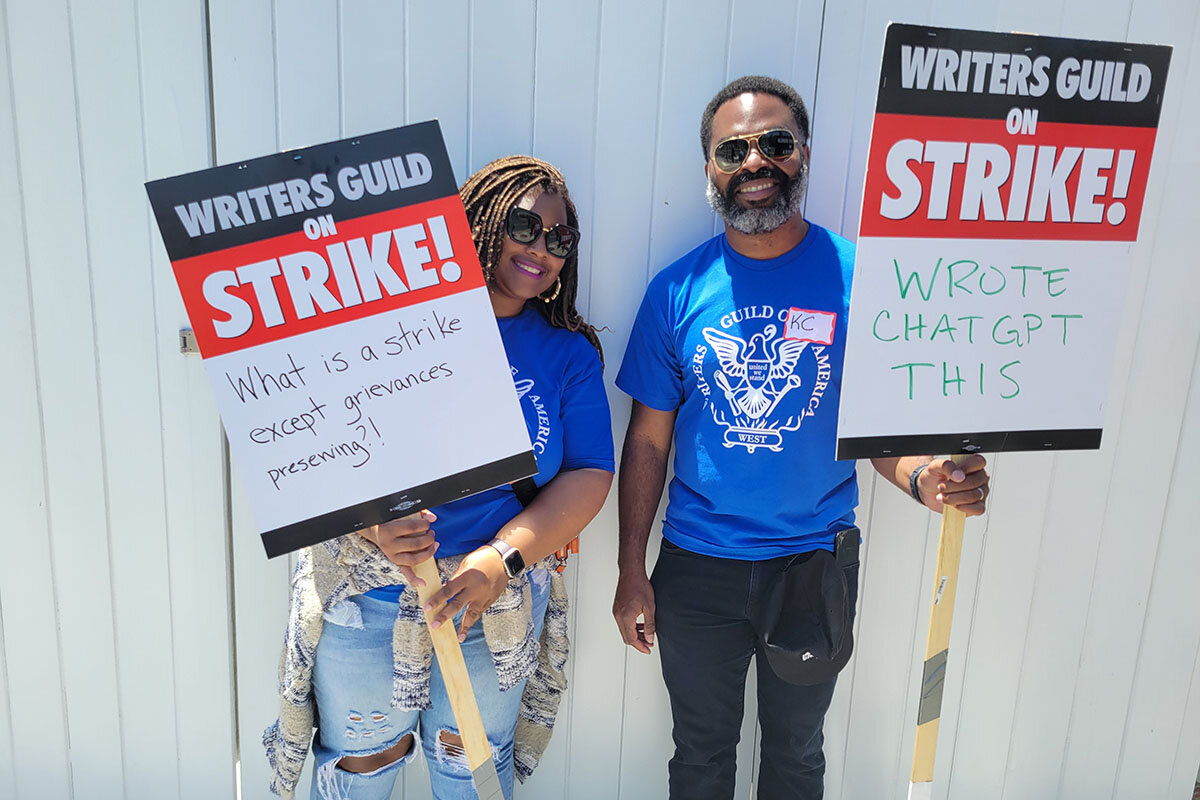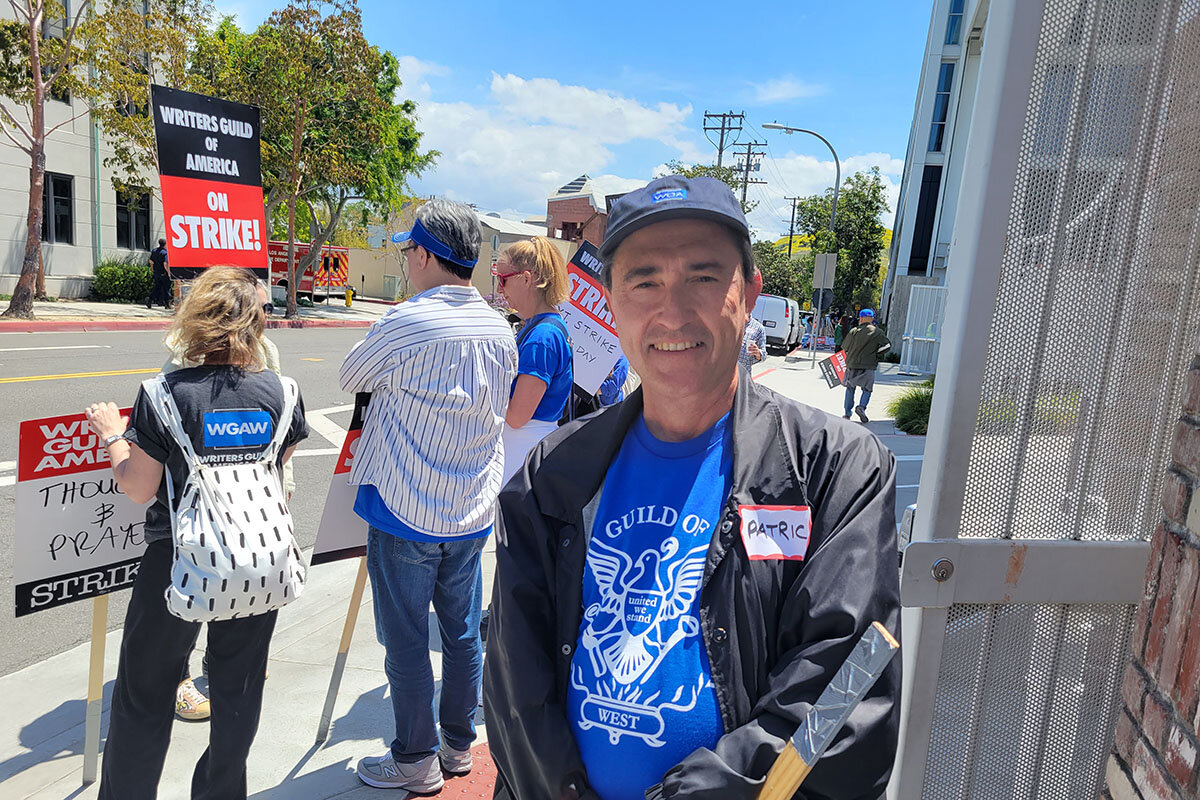Writers’ strike: Has the gig economy come for Hollywood?
Loading...
| Culver City, Calif.
From a distance, it sounds like a street party. Outside one of Hollywood’s oldest studios, people are cheering. A speaker blares Stevie Wonder’s “Living for the City.” Passing cars toot appreciative horns.
Up close, it becomes apparent this isn’t a party. It’s a picket line. When screenwriters across America went on strike on Tuesday, they started marshaling outside entertainment headquarters such as Amazon’s film and television division here at Culver Studios. The upbeat protesters, wearing sunglasses and “Writers Guild of America” T-shirts, chant “union power” while parading around the colonial-style building where “Gone with the Wind” was filmed. These writers claim that studios are turning their profession into a gig economy consisting of short-term jobs with low pay and even uncompensated work. As one striker’s sign puts it, “Hey Amazon, free delivery is your job, not ours!”
“What’s happening right now is just abject disrespect of writers,” says K.C. Scott, a scribe on the Apple TV+ show “Physical,” whose boombox is playing Bob Marley & The Wailers’ “Get Up, Stand Up.” “When I was starting my career, someone said, ‘You go to New York as a writer if you want respect. You go to LA if you want money.’ And, right now, we’re not getting either.”
Why We Wrote This
A story focused onHow much are writers worth? For studios, the answer may be a financial calculation. For writers, that question isn’t just a monetary one. It’s also a matter of feeling seen and valued.
The first writers’ strike in 15 years followed a breakdown in talks between the Writers Guild of America (WGA) and The Alliance of Motion Picture and Television Producers (AMPTP). The standoff revolves around financial compensation and job security in an era when streaming has reshaped Hollywood. In a document released Thursday, the AMPTP disputed the accuracy of WGA’s “gig economy” claims and also touted a proposed contract that includes “the highest first-year increase offered to the WGA in more than 25 years.”
The negotiations come down to an all-too-familiar dispute in Hollywood: How much are writers worth? For studios, the answer may be a financial calculation. For writers, that question isn’t just a monetary one. It’s also a matter of feeling seen and valued.
“Writers are seen as the essential cog in the wheel,” says Dominic Patten, senior editor at Deadline Hollywood, an industry news publication. “But I think that what’s happened in recent years, it’s more systematic and institutional. … We’ve seen a change, especially with the advent of streaming, in the way that the entire system works.”
The last time writers went on strike was for 100 days that spanned 2007 and 2008. The toll on California’s economy is estimated to have been $2.1 billion.
Fragmented audiences, fragmented pay?
Back then, audiences were already fragmenting as entertainment options expanded, but mainstream media was still relatively ... mainstream. Successful movie script writers could expect bonanza paydays in an era in which studios released major competing films every weekend. Established writers on a network or cable TV show could make a good living over the course of a 22-episode season. If a series was reincarnated on DVD or TV syndication, there were additional residual payments.
Today, three of the TV writers picketing outside Culver Studios say that was something of a golden era.
“It was just 10 years ago that we were all entry-level writers and we got a job that could sustain us for that year, even on a show that got canceled,” says Eli Bauman, a writer for award shows such as the Emmys, standing alongside his wife, Joanna Calo (“The Bear”), and their longtime friend Raphael Bob-Waksberg (“Bojack Horseman”).
In 2007, streaming was barely a twinkling pixel in the eye of big tech companies. Apple had only just unveiled the iPhone. Netflix, a mail-delivery DVD service, had only just launched video. Amazon’s focus was selling Kindles and fresh groceries, on demand.
Then in 2013, Netflix televised a revolution by erecting “House of Cards,” its first original show.
Within a decade, the company pioneered a process of more creative destruction than an episode of “Squid Game.” In the race to maximize content, streaming competitors have acquired and consolidated vaults such as MGM, and even whole studios such as 20th Century Fox. The shift to streaming has boosted the number of new Hollywood productions. Last year, a record 599 original scripted shows aired in the United States. The beneficiaries of that boom aren’t just stockholders, but also the production crew workers such as casting agents, set designers, hair-and-makeup artists, electricians, cinematographers, VFX artists, and even the assistants tasked with fetching kombucha lattes for the directors.
But writers say they’ve been short-changed by the new business model. For starters, on streaming shows, a season typically only consists of eight to 10 episodes.
“It’s a paradox because you would think with so many more shows, there’d be more jobs for writers,” says Jessica Sharzer, a screen captain at the WGA, in a phone interview. “The writers’ rooms literally shrunk. So they used to have, let’s say … 10 writers in them, now they have six.”
Most concerning, Ms. Sharzer says, is a widespread phenomenon dubbed “mini rooms.” If a production entity likes a pilot script, it may give a showrunner a minimal budget to hire two or three additional writers to develop the show. If the show doesn’t end up in development, it’s not a big loss for the company. But the writers take the brunt of the risk. The minimum pay they earn, around $5,000 a week, needs to stretch to payments to agents, lawyers, and the taxman. There’s no guarantee the scribe will be hired for the show or even credited for their work. The short-term hires may never set foot on set, a crucial step to becoming a showrunner.
“They’re also not getting the same level of growth and opportunities that they once did in that older model where you could grow as a writer, starting in the trenches, so to speak,” says Brian Welk, a senior business reporter for IndieWire, a film industry site. “So maybe that’s why they’re feeling disrespected.”
Studios push back on “gig economy” claim
Thursday, the AMPTP stipulated that it had offered to improve the pay structures and minimum rates for such development rooms. Moreover, the trade association pushed back against WGA language that compares writers to freelancers in a gig economy.
“Most television writers are employed on a weekly or episodic basis, with a guarantee of a specified number of weeks or episodes,” the negotiating body for studios and streaming companies wrote in its four-page document. “It’s not uncommon for writers to be guaranteed ‘all episodes produced.’”
It added that television writers enjoy health care, parental leave, and pension benefits “that are far superior to what many full-time employees receive for working an entire year.”
Other impasses in contract negotiations are over residual payments for streaming shows, script fees for staff writers, and the WGA’s insistence upon a mandatory minimum number of staff writers per show as well as guarantees of the length of employment. Deadline Hollywood recently wrote that AMPTP President Carol Lombardini “is widely seen as a tough but fair negotiator” who is keen to keep production costs from ballooning.
But during the discussions, former WGA West president Patric Verrone perceived a lack of respect.
“That may have been one of the differences between this negotiation and the others I’ve been involved in,” says Mr. Verrone, eyes squinting in the modest shade of his WGA cap. “There was a different atmosphere.”
The “Futurama” writer speculates that may stem from the change in the composition of AMPTP since the arrival of Netflix, Amazon, and Apple. But as much as writers may crave esteem, he says it won’t put bread on the table.
“As long as I’ve been in the Guild leadership, it’s become much more evident that we can get all the respect that they’re willing to dole out, but they will only make the ... financial deal that we need, that we demand, if we can show power and leverage.”
The question becomes which side will blink first.
“In many ways, the timing for the writers couldn’t be worse as far as coming to the negotiating table,” says script consultant Tom Nunan, a former TV executive and producer of the Oscar-winning film “Crash.” “The media companies themselves are going through this terrible reckoning. After years of overspending and explosive growth, they’re now in what seems to be an unending period of contraction.”
Some believe that the studios and streaming companies, which have been laying off thousands of employees, are in a position of strength in this strike. In fact, they may even have reasons to welcome the disruption to production.
“The studios think that eventually enough writers will realize that they’re having trouble paying their rent or their mortgage and demand their leadership go back to the negotiating table,” says Mr. Patten from Deadline. “And the studios, of course, can start canceling some deals after 30 days go by. ... They can save some money on the books.”
The wider cost of the strike could be disastrous for an economic sector that’s still woozy from the punch of the pandemic. Yet many unions, including local Teamsters, International Alliance of Theatrical Stage Employees, the Screen Actors Guild – American Federation of Television and Radio Artists, and the Directors Guild of America – which begins its own contract negotiations with AMPTP next week – have expressed their solidarity to the WGA. Outside Culver Studios, virtually every passing car honks its horn to show support.
Standing next to the hedges near the mansion where Rhett Butler wooed Scarlett O’Hara, Mr. Bauman, Ms. Calo, and Mr. Bob-Waksberg say that the strike has a resonance that goes beyond New York or Los Angeles.
“I do think that’s something that anyone in America can kind of understand, especially as we all are kind of finding ourselves in a gig economy to some extent,” says Mr. Bauman, the Emmys writer. “All we’re asking for is some version of sustainability and stability and respect.”
Editor’s note: This article has been updated to correct the spelling of Tom Nunan’s last name.








